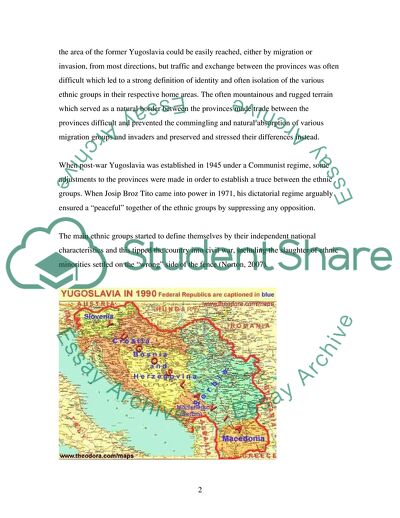
- Home
- Free Samples
- Premium Essays
- Editing Services
- Extra Tools
- Essay Writing Help
- About Us
- Studentshare
- Subjects
- Miscellaneous
- Conflicts in former Yugoslavia
Conflicts in former Yugoslavia - Essay Example

- Subject: Miscellaneous
- Type: Essay
- Level: Ph.D.
- Pages: 4 (1000 words)
- Downloads: 0
- Author: xtorp
Extract of sample "Conflicts in former Yugoslavia"
The only comparison that springs to mind is the willful construct of the borders of African nations whose shape was outlined by their former colonial powers irrespective of tribal borders or ethnicity or common background of the population living within these borders. The results to this day are often not uncommon to what happened when the artificial structure of Yugoslavia collapsed. Joseph Stalin wrote in 1913: “A nation is a historically constituted, stable community of people, formed on the basis of a common language, territory, economic life, and psychological make-up manifested in a common culture.
” None of those factors can be applied to the former Yugoslavia. An interesting and contributing factor to the multi-ethnic mosaic of the population is the complex geography of the former Yugoslavia. The map below shows the provinces before the break-up including Slovenia, Croatia, Bosnia and Herzegovina, Serbia, Montenegro and Macedonia. The map also shows the bordering countries, Austria and Hungary to the North, Romania and Bulgaria to the East, Albania to the South West and Greece in the South.
From the geographical structure it can be gleaned that there is no logical reason for the borders to be where they are: there is often no geographical division to the neighbouring countries but there are geographical divisions within the different provinces, with up to 60% of the territory consistent of mountain ranges which were difficult to cross. These circumstances historically favoured two particular circumstances: the area of the former Yugoslavia could be easily reached, either by migration or invasion, from most directions, but traffic and exchange between the provinces was often difficult which led to a strong definition of identity and often isolation of the various ethnic groups in their respective home areas.
The often mountainous and rugged terrain which served as a natural border between the
...Download file to see next pages Read More
- TERMS & CONDITIONS
- PRIVACY POLICY
- COOKIES POLICY